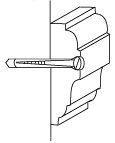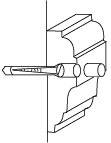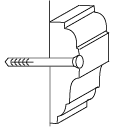How to fit dado rails
marking - fixing methods - cutting - fixing
First you need to decide on the height for the dado rail. When replacing an old dado rail, you have a good indication and it is probably best to refit at the same height.
Where no existing rail exists, dado rails are normally positioned between 1 and 1.2m (3 to 4 ft) up from the floor - a general rule is the higher the ceiling, the higher position of the dado rail.
Marking the height
Once you've established the height for the dado rails, first mark the height on the walls at each corner and then along each wall. Mark the walls around the room by:
- Starting from the mark in one corner, use a long straight edge and position a spirit level on the top side to get a horizontal then mark the line using pencil (when you reach the far corner, you will find out how level the floors are or how accurate you have been).
OR - Use a chalked line between the corner marks and snap the line to the wall.
OR - Position a laser level in the centre of the room and use the corner marks to establish the line along the walls - this will give the most accurate marking and is easy - you can hire a laser leveling kit from a most good tool hire centres.
Where a dado rail is to go up a stairway or slope, measure the required height for the dado rail at right-angles to the stairs from the front of the treads at the top and bottom steps, then use a chalked line between these marks to find the line of the rail up the stairway - then extend the line to intersect the marks for the horizontal rails on the walls at the top and bottom.
Cutting the dado rail moulding
Start by cutting the dado rail for the longest length of continuous wall, try to use just one length of rail, although for really long walls, 2 (or more !!) pieces may be required. If a wall is longer than a single piece of dado rail, then they should be overlapped by using opposite mitre cuts where they join along the wall run and both pieces of dado rail fixed about 30cm (1ft) from the joint and a couple of short lost head nails used to lock the joint.
 Cut the mitre on the ends of the first rail using a saw and mitre box, but note that if the wall finishes with an external mitre, the piece of rails needs to be longer than the flat wall, it's always best to cut external mitres before cutting the rail to length.
Cut the mitre on the ends of the first rail using a saw and mitre box, but note that if the wall finishes with an external mitre, the piece of rails needs to be longer than the flat wall, it's always best to cut external mitres before cutting the rail to length.
Two styles of mitres may be needed - internal and external, (see right) - to suit alcoves, chimney breasts etc. It is easy to get confused and cut the wrong type of mitre for a particular end - just remember that the wall length is always the measurement on the back of the dado rail.
Fixing the dado rail
You have a choice of ways to fix the dado rail to the walls, the three methods shown below are suitable for screw fixing into masonry walls. Where the walls are other than masonry (for example, stud partition or dry-lining), other methods will be required, options include screwing into the vertical studs or hollow wall plugs (for stud partitioning) or using a grip adhesive (for dry-lined walls).
 Drill and countersink the rail, drill the wall and fit a wall plug - then screw the rail to the wall - finish off by covering the screw head with filler or plaster
Drill and countersink the rail, drill the wall and fit a wall plug - then screw the rail to the wall - finish off by covering the screw head with filler or plaster
 Drill and counter bore the rail, drill the wall and fit a wall plug - then screw the rail to the wall and finish off by fitting a dowel plug to cover the screw head.
Drill and counter bore the rail, drill the wall and fit a wall plug - then screw the rail to the wall and finish off by fitting a dowel plug to cover the screw head.
Gives a better finish if the dado rails are to be stained or varnished.
 Drill and countersink the rail, drill the wall and fit a nailable plug fixing through the rail and into the wall - hammer the fixing home - finish off by covering the screw head with filler or plaster.
Drill and countersink the rail, drill the wall and fit a nailable plug fixing through the rail and into the wall - hammer the fixing home - finish off by covering the screw head with filler or plaster.
Fixings for dado rails should be placed about 30cm (1ft) from each corner and then at no more than 1m (3 ft) spacings. Drill the rail AFTER the ends have been mitred - then use the drilled rail as a template for drilling the wall.
Position the cut and drilled dado rail against the wall and with the top edge lined up with mark on the wall. Mark the positions for the screw holes through the rail onto the wall.
Remove the rail and drill the fixing holes in the wall as marked and to suit the method of fixing to be used.
Fix the dado rail in place along the longest, straight run wall and then work around the room; measuring the wall, cutting with appropriate mitres, then drilling and fixing the each piece of dado rail in turn.
Once all the dado rail has been fixed, cover the screw heads using a suitable filler or dowel plugs (fit with glue).
Once any filler or glue has cured, sand off the surface and then paint, stain or varnish the dado rail as appropriate.
